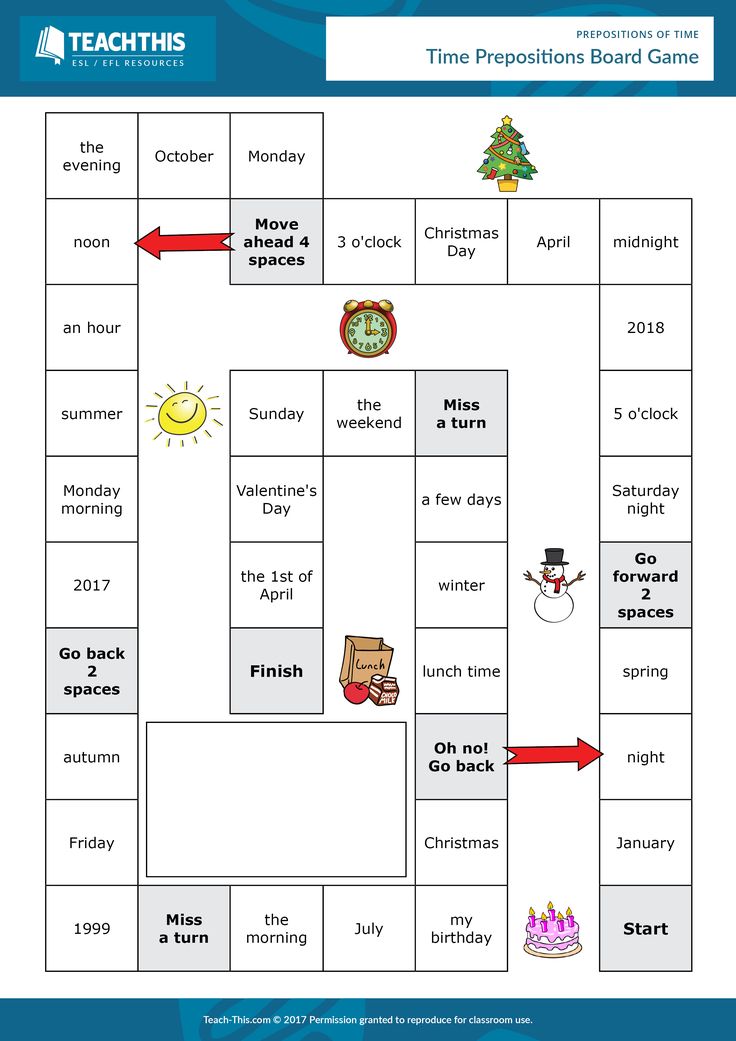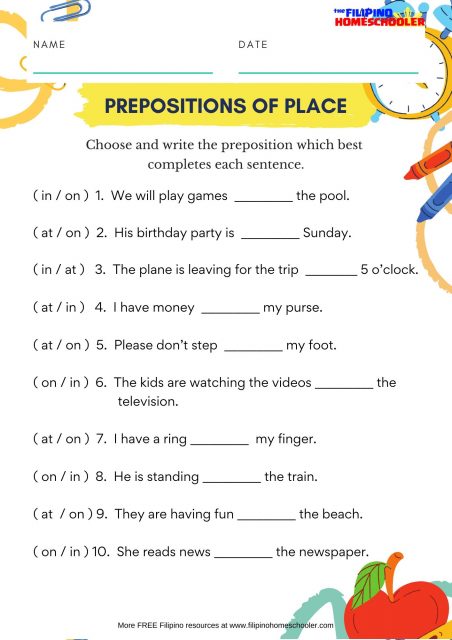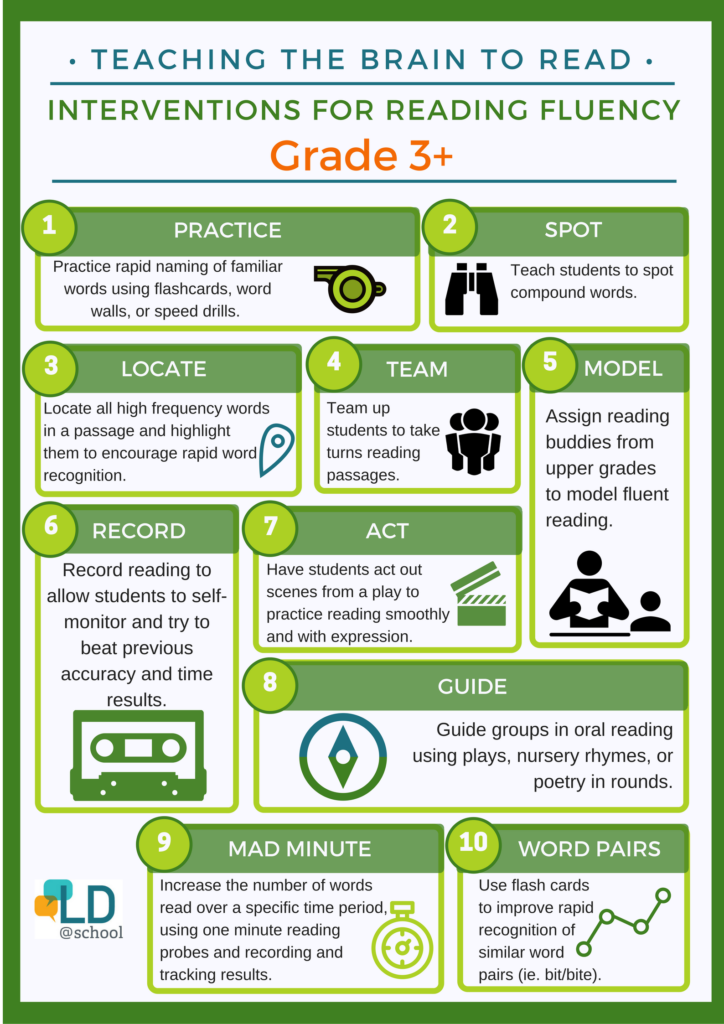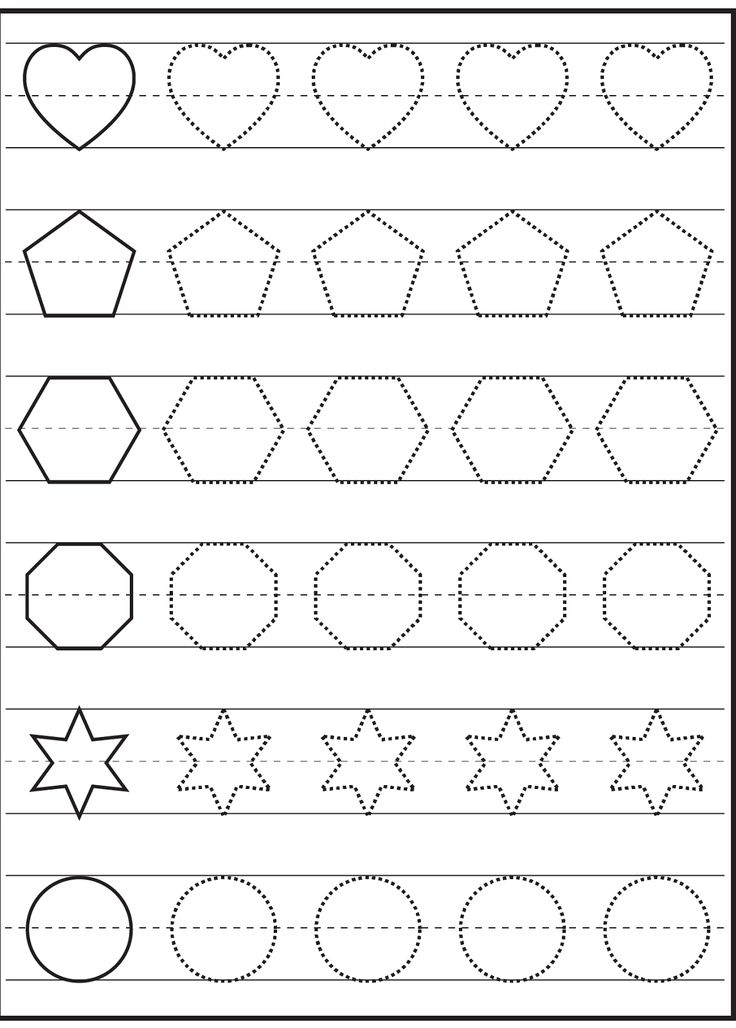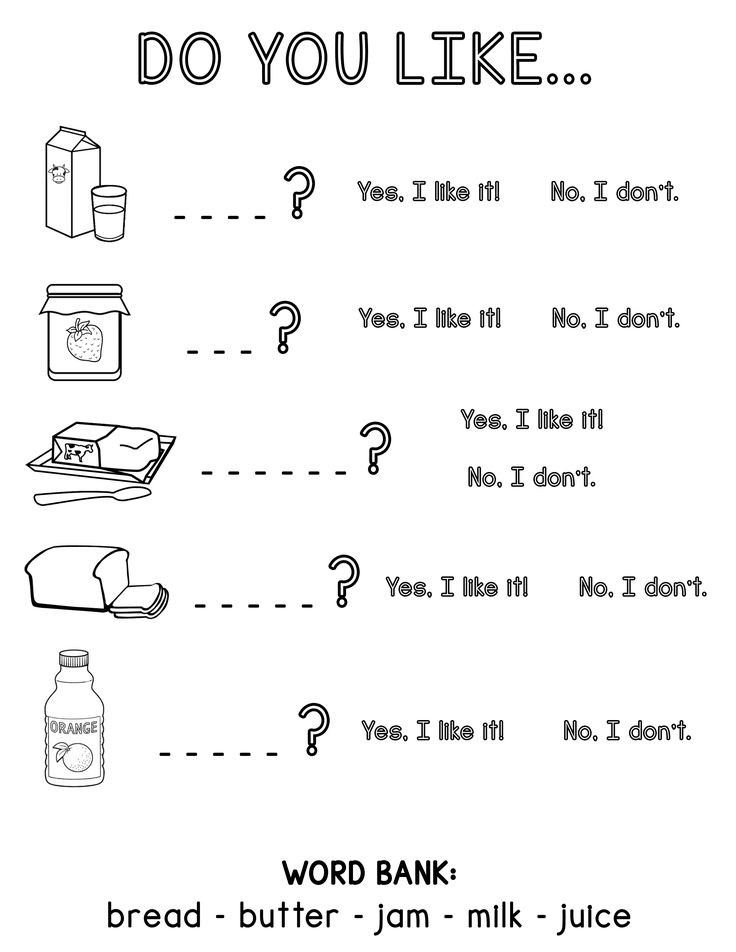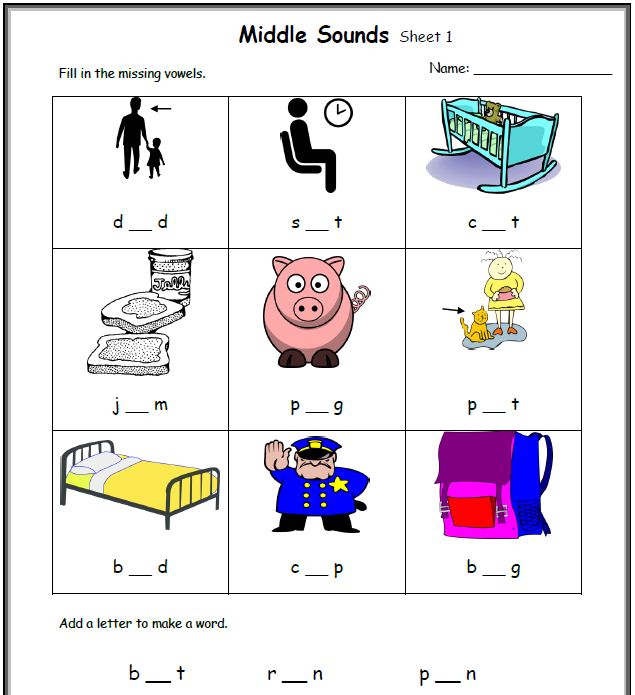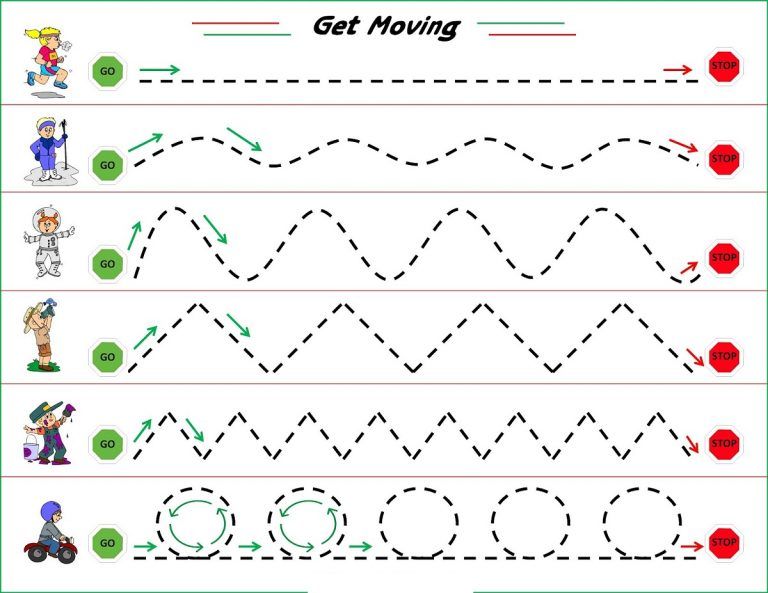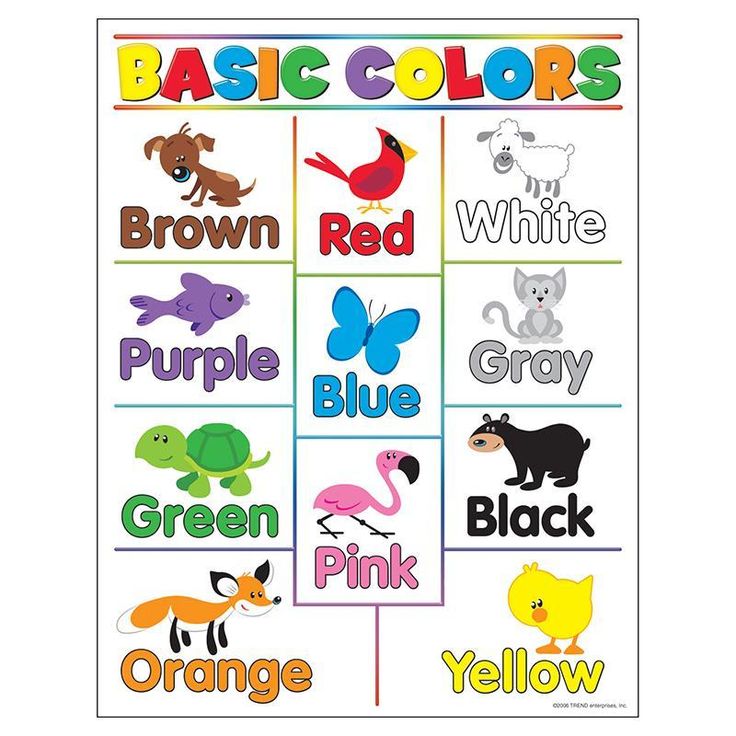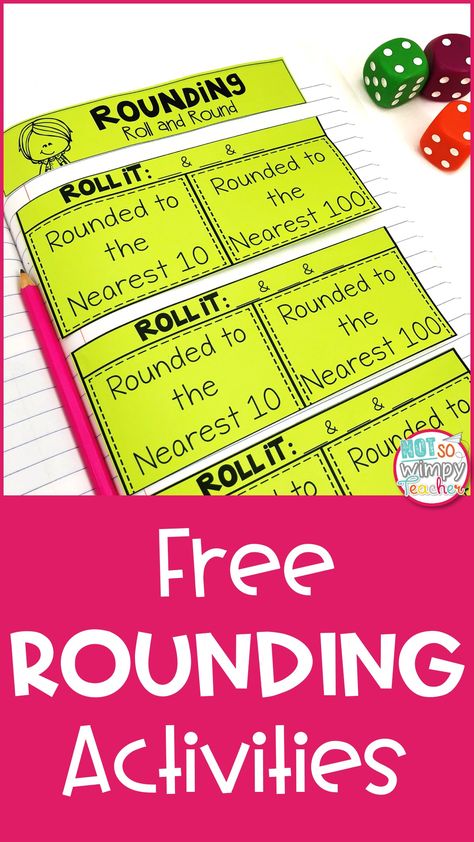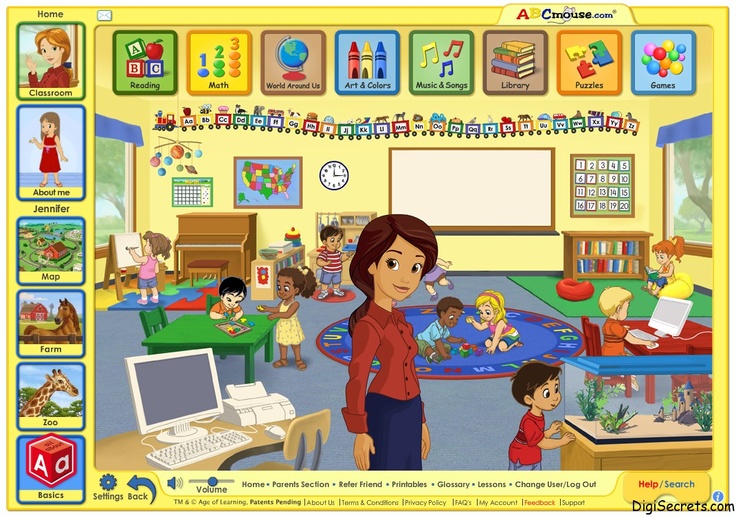Activities on prepositions
How to Teach Prepositions and Some Fun In-Class Activities
Prepositions are words governing, and usually preceding, a noun or pronoun and expressing a relation to another word or element in the clause. But to make your pupils understand the idea, explain to them that prepositions are words which link nouns, pronouns and phrases to other words in a sentence.
Table of Contents
What are Prepositions?
According to the Oxford English Dictionary, a preposition is a word governing, and usually preceding, a noun or pronoun and expressing a relation to another word or element in the clause. But to make your pupils understand the idea, explain to them that prepositions are words which link nouns, pronouns and phrases to other words in a sentence.
When describing the position of something, the time when something happens or the way in which something is done, we use prepositions.
Functions of Prepositions.
The function of a preposition is to demonstrate the relationship between two words in a sentence, normally between a noun, verb or adjective and a noun (including proper noun), pronoun, or gerund (verb in noun form). For example:
- I ran into the classroom.
- The lady beside Peter.
- She spoke to him.
- He is passionate about swimming.
- I went to Singapore.
A preposition is normally followed by a noun or pronoun and together they form a “prepositional phrase” (about swimming, into the classroom, beside Peter).
Forms of Prepositions.
Prepositions have no settled form. The most common prepositions are one-word prepositions (on, before, into), however there are two- or three-word phrases known as complex-prepositions that we use in our daily lives (according to, along with, in spite of). One thing to notice is that you should make sure that your pupils know the differences between “Complex prepositions” and “prepositional phrases”.
Many prepositions have literal meanings (in the room) or metaphorical meanings (in love). The meanings can be sorted in categories, for example:
- place — under the desk
- time — on Thursday
- purpose — done for school
- possession — a product of mine
- manner — by bus
- means — with a guitar
- movement — towards the rear
- accompaniment — without a tool
Some prepositions belong to more than one category, for example “on the table/on Saturday, with his wife/with a hammer).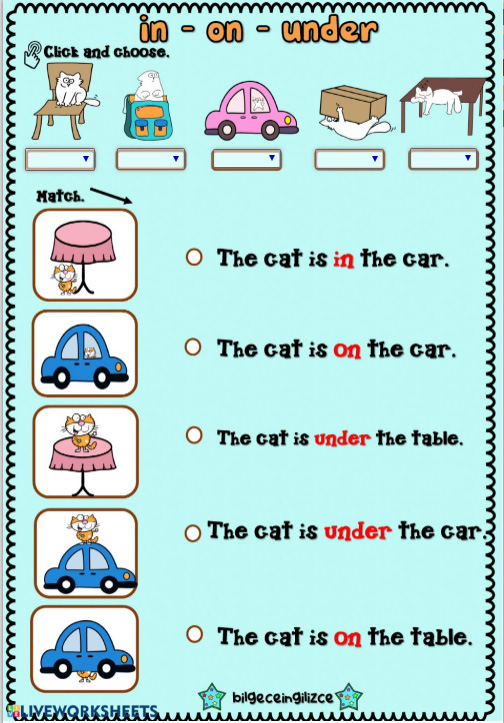
Metaphorical prepositions are those which are used originally to express space, but then expand their meanings to other functions such as means, manner, etc. They are metaphorical since they have a link to the original meanings but extended based on the idea of polysemy.
Many prepositions can also be adverbs. A preposition always has an object. An adverb does not have an object. For examples:
- “They are in the bedroom” vs “Please come in” (no object).
- “There was a car before me” vs “I had never seen it before” (no object).
- “I will call after school” vs “She called soon after” (no object).
There is one very simple rule about prepositions: a preposition is always followed by a “noun” (occasionally the noun may come before the preposition). It is never followed by a verb.
By “noun” we mean:
- noun: cat, love, potato
- proper noun: Paris, Lucy, English
- pronoun: us, you, him
- noun group: my first car
- gerund: singing
Fun In-Class Preposition Activities.
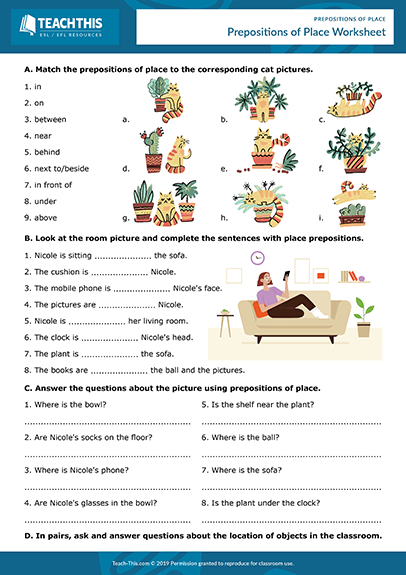
The “Do As I Say” Game.
Put children in pairs, and set a bar or put a desk in front of each pair. On your command children move into a position that illustrates the preposition that you name.
For “under” or “on” children can use the table or the bar, “In front” or “behind” can be done with two pupils, one standing behind or in front of the other. “In” and “out” might be shown with one pupil making a circle with his or her arms, while the other kid stands in the circle or out of it.
The Classroom Ghosts.
Tell your pupils that you have a bad news: there seems to be a naughty ghost in the classroom. The ghost misplaced some items when you left the room yesterday, and you can’t remember what was where, and you need their help.
Prior to this activity you will have to move some things around. For example, you could place some bricks under a pupil’s chair, put a marker pen on the bookshelf, put a doll on the teacher’s chair, or put the clock behind the door, etc.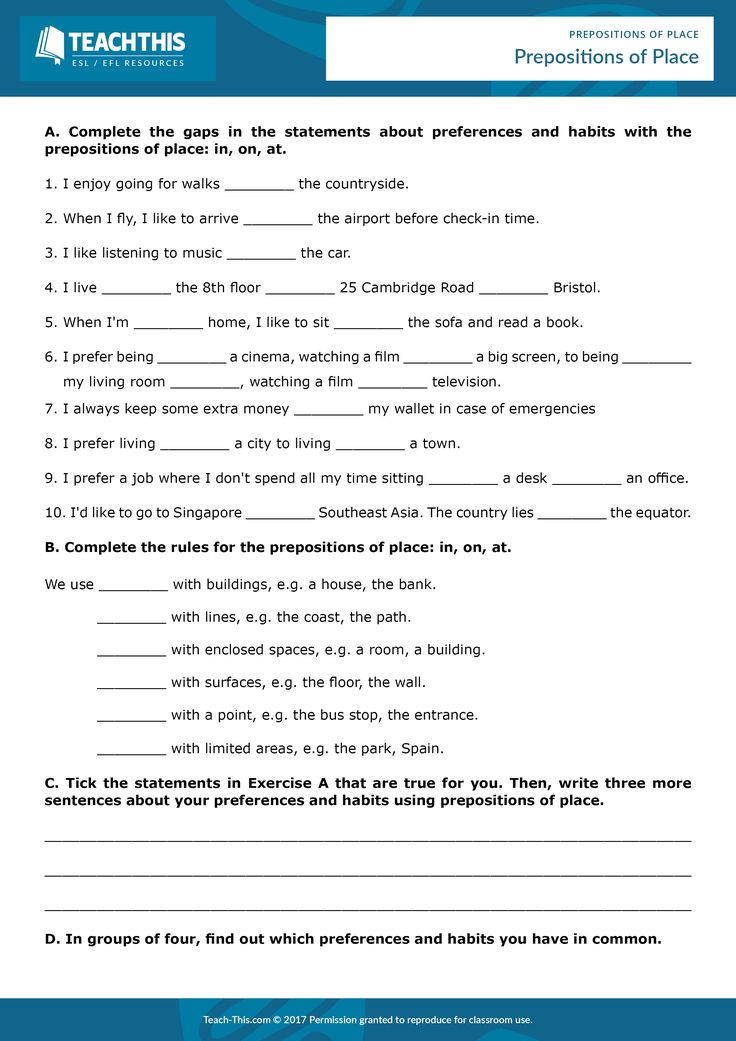
Get pupils into pairs to make a note of what the ‘ghost’ has moved around, and ask them to use ‘prepositions of place’ to make sentences. For example:
The clock is at the wrong place. It should be on the wall.
The bricks are under someone’s chair. They are usually on the shelf.
You could even assign a child as the secret ghost to make a few more changes to the classroom objects for the following day, and then review again with your class to check what they remember.
Grand Designer.
Put your students in pairs, and ask them to describe their ideal bedroom or living room to each other. Tell your class to imagine that they have all won the lottery and they are able to buy their dream house. Ask them to write a detailed description of their ideal homes, using prepositions of place, to give to an interior designer. You can either limit this to one or two rooms, or get the students to design an entire house. Since they are doing this activity in pairs, they may have to make compromises during designing:
Pupil A: There should be a big TV on the wall in the bedroom.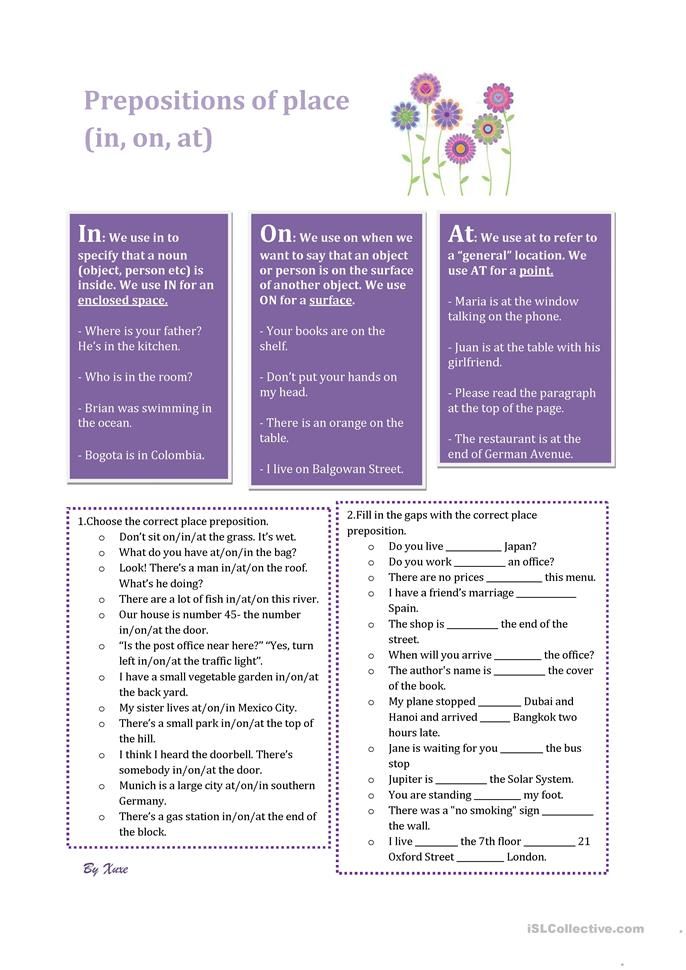
Pupil B: I like a big screen but I would prefer it in the living room.
Once finished, students can join another pair and share ideas. The first pair can describe their dream house and the other pair can try to sketch it.
Scavenger Hunt.
This activity can be done on the whole school premises or within the classroom if your classroom is big enough. Put children in groups of fours or fives, create several clues, give each small group of students one handout with instructions, and take a picture at each point on the scavenger hunt. Clues and instructions can be like:
Walk towards the school gate. There is a poster of a concert on the wall as you walk out of the building. Take a picture of yourself with the poster.
Along the playground, you will see a statue of a penguin. Take a selfie with it.
The List Challenger.
Assign pupils into small teams, at a maximum of four per team. Tell them that you will give them a list of ten prepositions.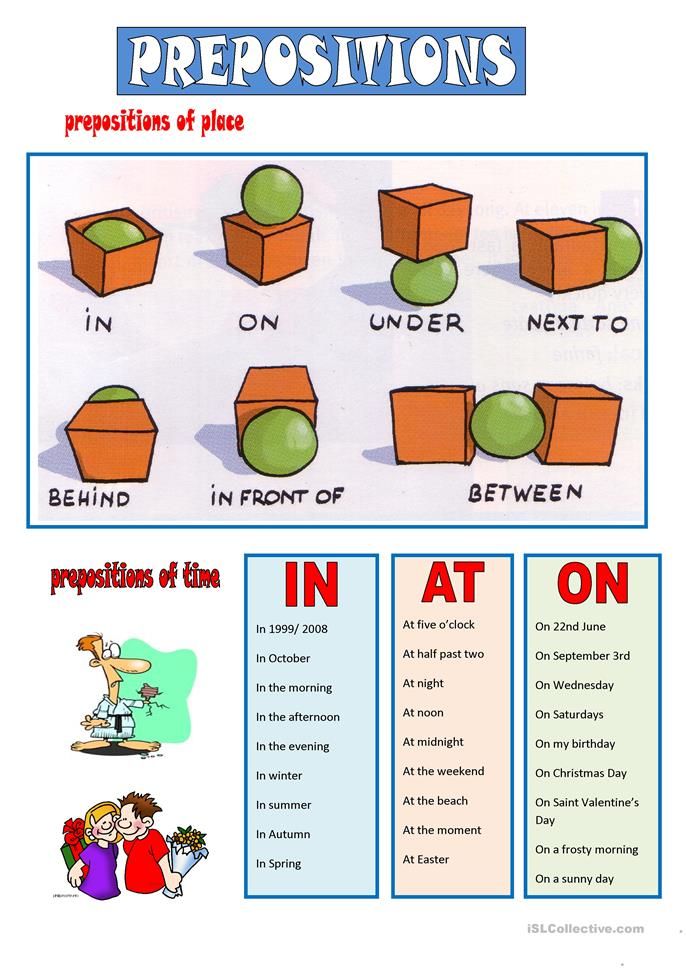 Each team must try to create as many sentences as they can using the ten prepositions. Write the prepositions to be practised on the board, such as: on, in, under, in front of, into, above, behind, at, below, between.
Each team must try to create as many sentences as they can using the ten prepositions. Write the prepositions to be practised on the board, such as: on, in, under, in front of, into, above, behind, at, below, between.
Then, pick two teams and ask them how many sentences they think they can produce. Both teams will then work closely together to write eight and ten accurate sentences. After finished, ask both teams to try and spot any mistakes the other team has made. If both teams accurately produce the number of sentences they said they could and has no mistake, they are awarded that number of points. For example if Team A claimed that they can writer 7 sentences and they wrote 7 with nothing wrong, that’s 7 points for them. If a team gets even one sentence wrong, or does not get the number they said they would, they get zero points.
Grammar with Emile
If you are tired of making props for activities, or you just need one activity that can do all the tricks and get all of your pupils engaged(even the most inactive ones), then you need Grammar with Emile.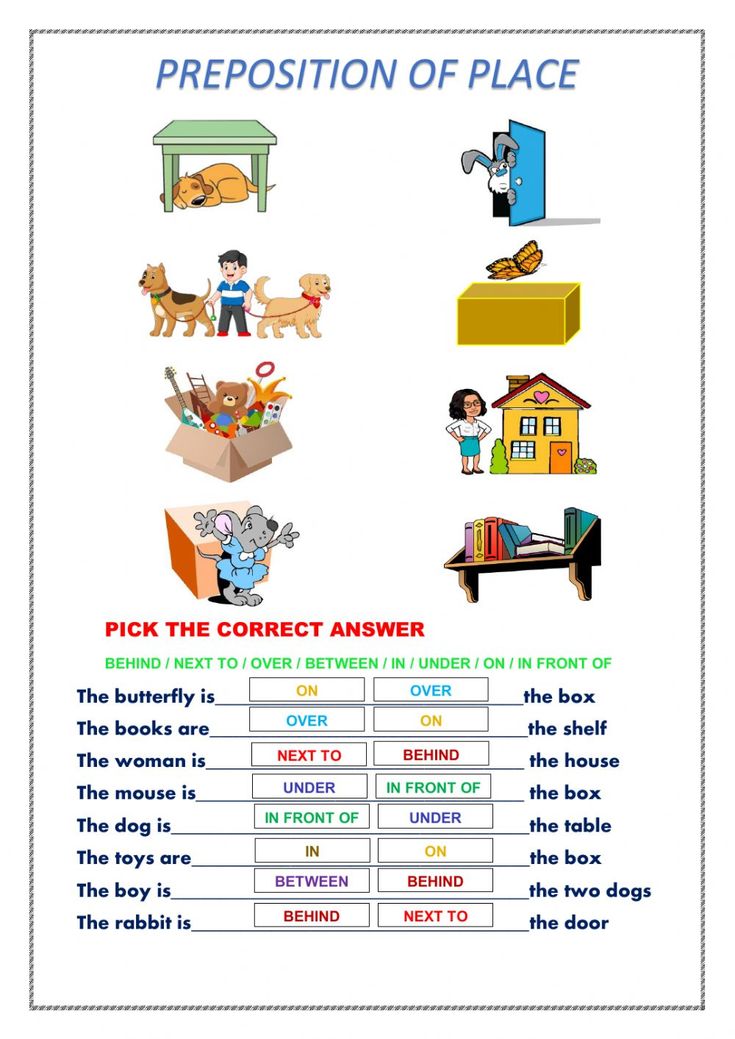
It’s a resource on computers or tablets that can easily grab students’ attentions with cute cartoon characters and cool animations, and it actually offers an Assess, Practice and Achieve Model which automatically assess a pupil’s current ability on a certain subject, assign the proper level of practice questions for the pupil to do, and teachers can just sit back and wait to see their pupils achieve a higher level (better marks and improved overall understanding of a subject).
More of our Grammar Blogs
Getting Intimate with English Prepositions: 6 Unique Exercises That Get Students Moving
By susanverner Last updated:
Is a bird in the hand really worth two in the bush?
The answer is yes, when you’re talking about teaching.
Making teaching sensory—that is, getting students’ senses involved while learning—is the ultimate way to teach.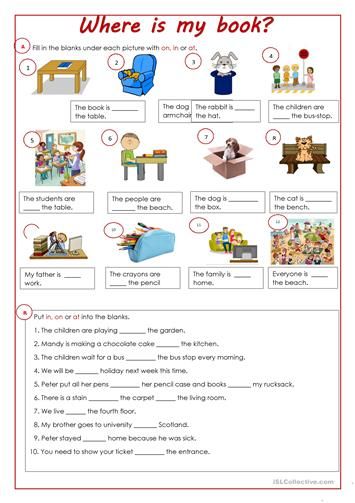
And while most lessons include a visual and aural aspect, including the sense of touch is often the difficult part. It’s especially challenging when teaching something as intangible as the English language.
But fear not!
Here are some simple ways you can get students moving and manipulating when it’s time to teach English prepositions.
Download: This blog post is available as a convenient and portable PDF that you can take anywhere. Click here to get a copy. (Download)
Why Use Hands-on Activities to Teach English Prepositions?
Before we talk about specific ways to be hands-on when teaching prepositions, it’s helpful to remind ourselves why we want our students to be hands-on in the first place.
First of all, hands-on learning is one of the three main learning styles students possess. The buzz word we are looking for is kinesthetic learner. All that really means is that some students learn best when their sense of touch is involved (where others depend primarily on their sense of sight or hearing).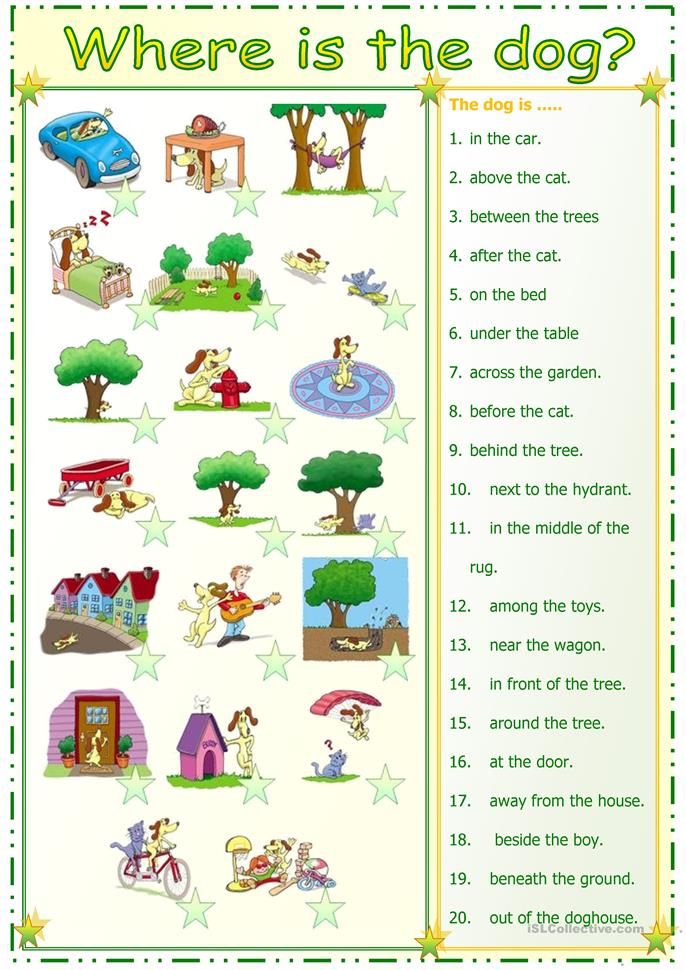 Hands-on learners are often the ones to whom standard lesson plans don’t cater, so it’s worth making a point to include movement-based activities when planning any lesson.
Hands-on learners are often the ones to whom standard lesson plans don’t cater, so it’s worth making a point to include movement-based activities when planning any lesson.
Another reason to teach hands-on is because research shows it’s one of the most effective ways to teach a second language. The teaching method known as TPR (total physical response) intentionally associates physical movements with language instruction. The method is so effective, even false beginners thrive under this type of instruction. Some classrooms rely completely on TPR for instruction, but I find that blending movement activities with other teaching methods is most effective at any level ESL class.
Finally, hands-on teaching gives your students a great experience. If someone asked me about the most meaningful lecture I heard in high school, I’m not sure I could name one. I can, however, tell you about several hands-on activities I did in those otherwise less than memorable classes. Students remember the activities that involve their whole person.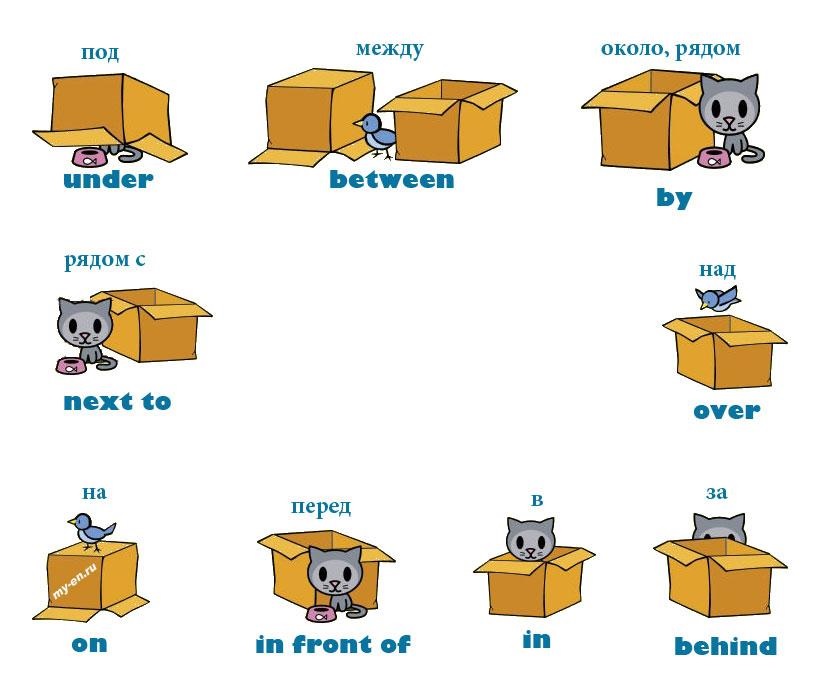 They engage more easily and remember information better. Most of all, they tend to have fun, and all of that is what makes hands-on lessons essential and effective.
They engage more easily and remember information better. Most of all, they tend to have fun, and all of that is what makes hands-on lessons essential and effective.
So enough about the whys of hands-on preposition teaching. Let’s get to the hows.
6 Brilliant Hands-on Exercises That Teach English Prepositions
If your students struggle with prepositions (which definitely happens), it can be beneficial to show them some native preposition use models with FluentU.
FluentU takes authentic videos—like music videos, movie trailers, news and inspiring talks—and turns them into personalized language lessons.
Seeing the prepositions used in context can help the student’s comprehension. If you want to discover all the other great ways FluentU can be used to highlight grammar and English generally, then be sure to request a free trial.1. Draw My Directions
Drawing is a simple way to engage students’ bodies as well as their creativity when they’re learning about prepositions.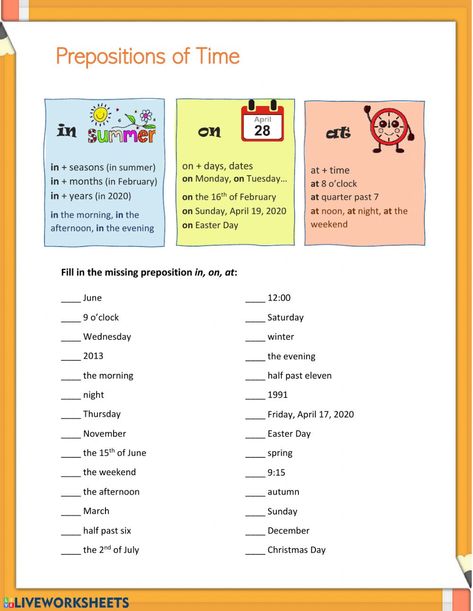 In this exercise, you will give instructions for drawing a picture without telling your students the object they are drawing.
In this exercise, you will give instructions for drawing a picture without telling your students the object they are drawing.
As you give the instructions, you should use prepositions to describe each piece of the picture in relation to the other. Students will not be able to see the picture you are describing.
For example, if you wanted students to draw a simple house, you might give these instructions:
Draw a large square on the bottom half of your paper. Draw two small squares inside the large square at the top. The small squares should be opposite each other.
Draw a rectangle under one of the small squares. Draw a triangle on top of the large square. Draw a small circle inside the rectangle. It should be in the middle of the rectangle and to one side.
Finally, draw two lines through each small square dividing it into four smaller squares.
After you give the directions, hold up your picture so they can see what they were drawing was a house, and let students see how close they got to the original picture.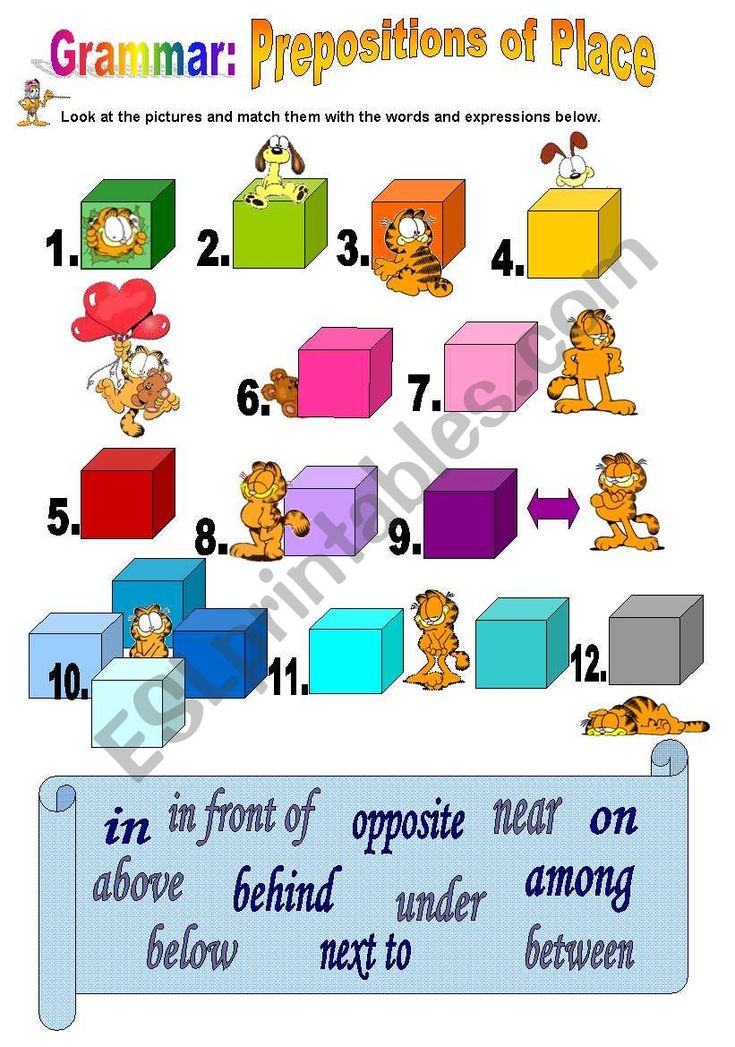
You can do a more complicated version of this activity by collecting several pictures from magazines. Match each student with a partner, and have the two sit back to back. One person will describe the picture without telling the other what it is, while their partner draws following the directions they hear. Be sure to give each student a chance to describe and draw using a different picture each round.
2. Preposition Simon Says
I love to use games in my classroom, as they’re so fun and functional. Simon Says is a great favorite, especially when my students look like they’ve been sitting too long. You can do a simple version of Simon Says to teach and review prepositions.
Have all of your students stand, and choose one object that everyone has and can use while playing.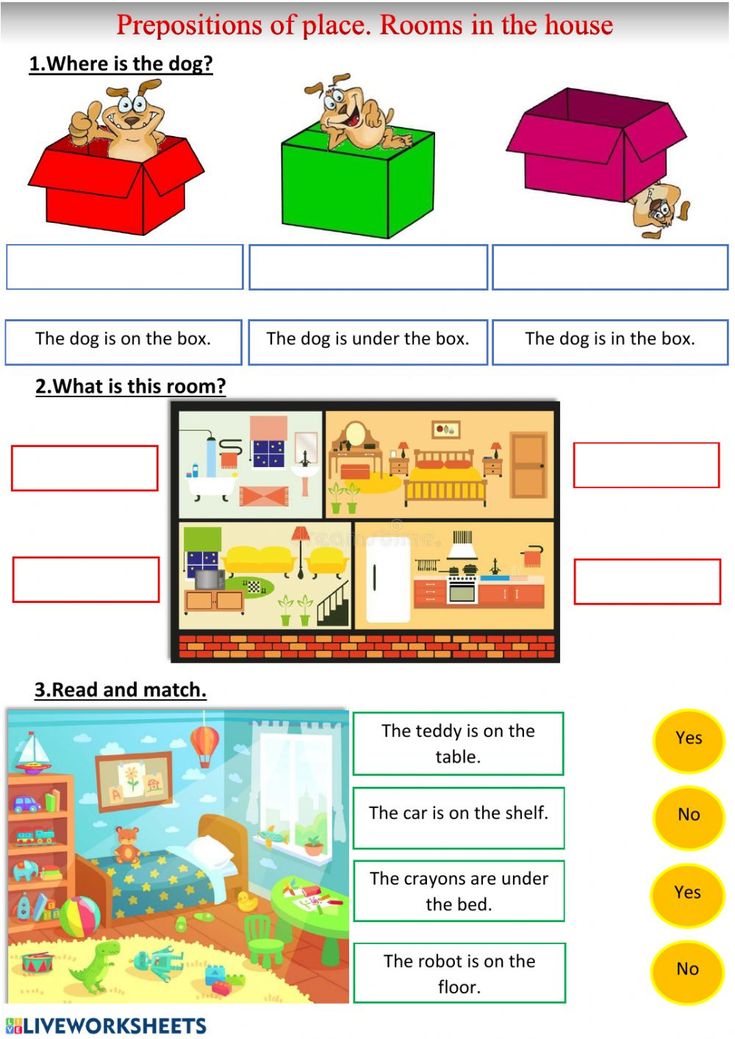 You might choose a pencil, a book or their desk chair. Play the game as you normally would, but with each instruction use a preposition to describe where the player is in relation to the object you are using.
You might choose a pencil, a book or their desk chair. Play the game as you normally would, but with each instruction use a preposition to describe where the player is in relation to the object you are using.
For example, you might give instructions like the following:
Simon says stand on your chair.
Simon says put your hand under your chair.
Simon says hold your chair in front of you.
Just like in the standard game, if a person follows a command that is not preceded by “Simon says,” they are out. Also, if they do the wrong motion (e.g. put their hand on the chair when you tell them to put it under the chair), they are also out. The last person standing wins the game.
3. Four Corners
This active game challenges students to think before they move. They will be choosing the correct preposition to complete a sentence. Start by labeling each corner of your classroom with a preposition.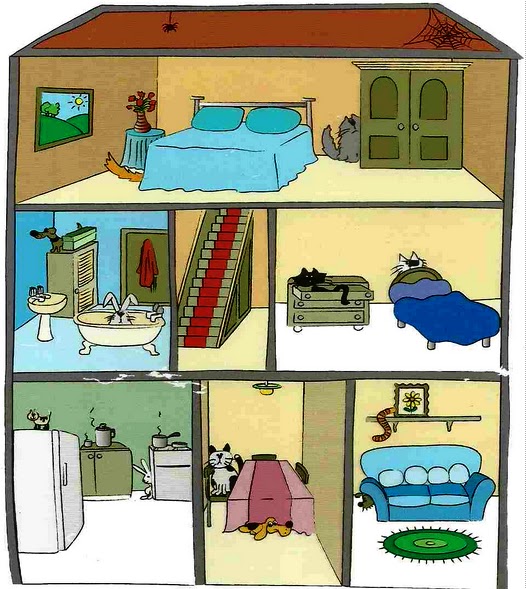 You can target prepositions of location, phrasal verbs or any other aspects of English prepositions you want.
You can target prepositions of location, phrasal verbs or any other aspects of English prepositions you want.
Have all your students stand in the center of the room with the furniture pushed out of the way. To play, you read a sentence aloud or project it at the front of the room. Replace the preposition in the sentences with a blank. After students hear the sentence, they must run to the correct corner of the room to complete the sentence logically.
For example, you might say, “My chair is blank my desk,” with the target answer being “behind.” Or you could say, “I went blank my notes to prepare for the test,” with the correct answer being “through.”
Any student who runs to the wrong corner of the room is out of the round. If no one runs to the wrong corner, that is if everyone chooses the correct answer, the last person to get there is eliminated. Keep playing until only one person remains. If you like, change up the prepositions in your corners and play another round.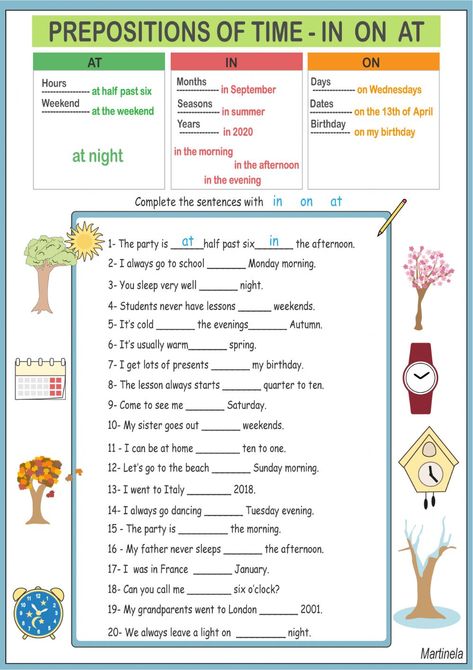
4. What’s Missing
This is a memory game that will necessitate the use of prepositions. Start by putting a tray or desk at the front of your room. The tray should have several common items on it–between five and ten is usually a good number. The more items you have on the tray, the more difficult the activity will be.
Give students one minute to study the objects on the tray. Then hide it from their view and either move one object or remove it. Now show the tray to your students again. They must determine what is different.
So if you moved an object, they might say, “The pencil is next to the pen now. Before it was across from the coffee mug.” If you remove an object, students might say, “The cup is no longer on the tray. It was in front of the pencil case, but it’s gone now.”
When students get good at noticing your changes, try removing one object and moving two or more others. If you like, award points to the first person to notice the change.
You can extend this activity by letting students arrange and move their own objects.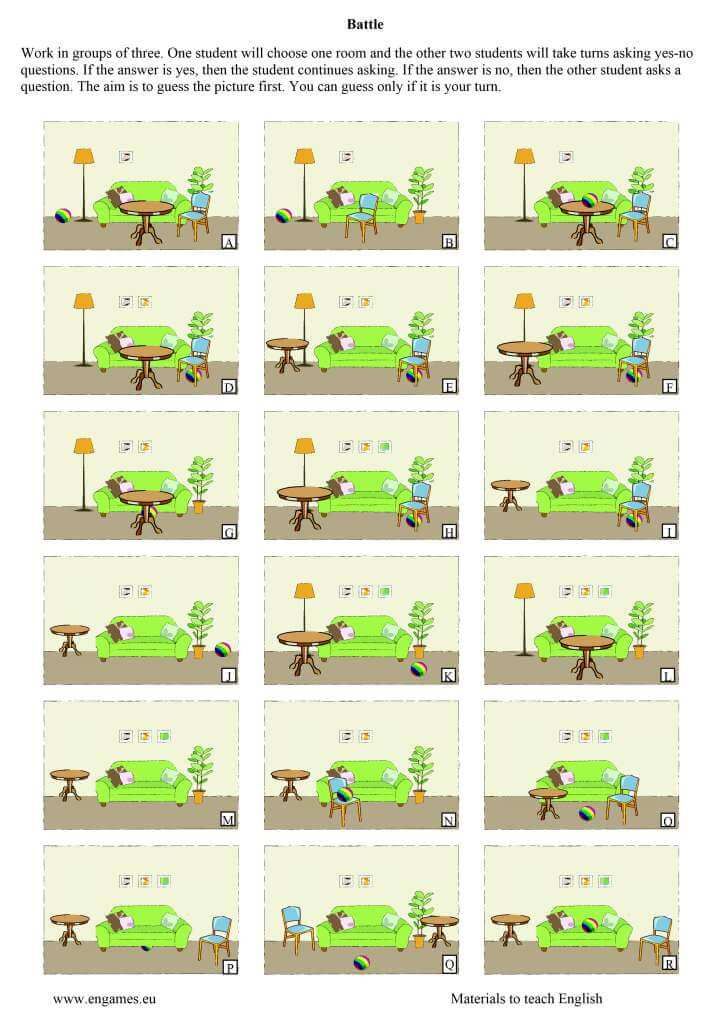 Give them several pictures or small objects to arrange on their desks, and have each person do the activity with a partner. Let students take turns moving the objects around and being the one to guess the changes that were made.
Give them several pictures or small objects to arrange on their desks, and have each person do the activity with a partner. Let students take turns moving the objects around and being the one to guess the changes that were made.
5. Paper Bag Neighborhoods
In this art/grammar activity, students will create their own model town based on the directions you give them. Start by giving each student written directions on how to build a paper bag house. You can find an example of the paper bag houses here. Your directions should include specifics locations for windows, doors, etc. These directions should include prepositions.
If you like, have several different versions of the directions so that not everyone’s house looks the same when it’s complete, or give different directions for schools, libraries and public service buildings. You can also let students decorate their houses. Then give the class instructions on how to arrange the houses into a town.
You’ll need a large area of your classroom or a blank bulletin board to hold the completed town.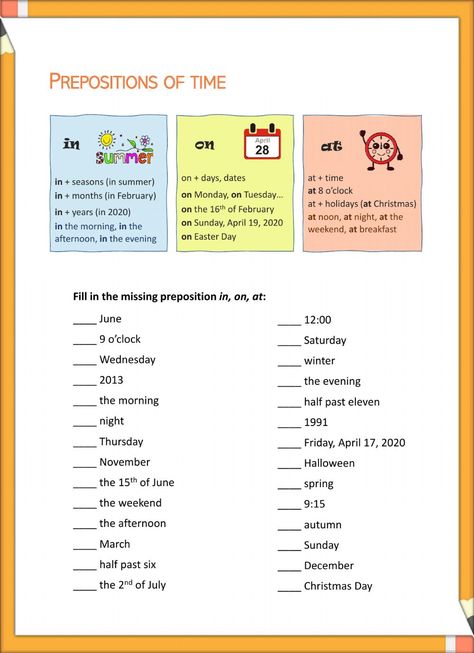 Make sure your town description also includes prepositions to specify where each building should go (e.g. the police station is across the street from the school). Have students work together to put their roads, landmarks and houses in the correct positions in the town.
Make sure your town description also includes prepositions to specify where each building should go (e.g. the police station is across the street from the school). Have students work together to put their roads, landmarks and houses in the correct positions in the town.
6. I Spy Lookout
Give students a copy of an “I spy” page or project one on your board. You can find some here.
Ask your students to find certain objects that appear in the picture. When someone has found the object, they share with the class where it is, but they are not allowed to touch the picture or point to the object. They must use prepositions to describe its position in relation to the other objects on the page.
You can also play this game in reverse. Have one student give clues to a certain object in the picture. Their classmates must then guess which object they’re describing, based on the clues. The person who first identifies their classmate’s object gets to describe the next one for the class.
You can have a lot of fun in the classroom when teaching prepositions, especially if you use these hands-on activities. It will benefit your students in many ways, plus you’ll have a more memorable and creative classroom as well as happier students.
Download: This blog post is available as a convenient and portable PDF that you can take anywhere. Click here to get a copy. (Download)
« 5 Otherworldly Applications for Cloze Reading in Your ESL Class
Here Are 10 Reasons You Should Say “Yes!” When Your ESL Students Beg to Go Outside This Spring »
Classes of prepositions in Russian
Today we will figure out what prepositions are in Russian, what categories these parts of speech have and how to write them correctly - together or separately. Go!
What are prepositions and what are they like
Preposition is a service part of speech that expresses the syntactic dependence of some words on others in phrases and sentences.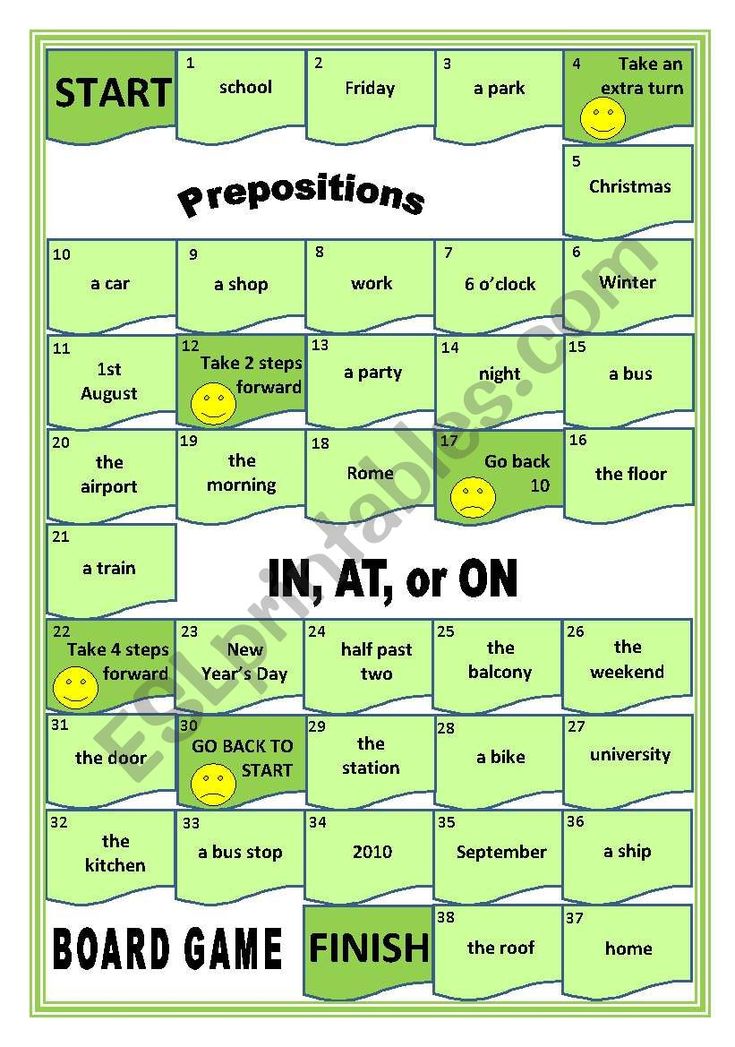
Prepositions are placed before nouns, numerals and pronouns in different cases. At the same time, this part of speech is not used with words in the nominative case. Prepositions are divided into 3 categories: by origin, by composition and by meaning. Let's take a look at each of them.
Classes of prepositions by meaning
By meaning, the prepositions of the Russian language are divided into prepositions of time, place, reason, purpose, concession, object and mode of action. Consider them in a table with examples.
| Types of prepositions according to their meaning | ||
|---|---|---|
| View | Prepositions | Example |
| Time | In, to, before, after, through, after, during, in continuation, in conclusion | By noon, after lunch, during pm, during weeks, etc.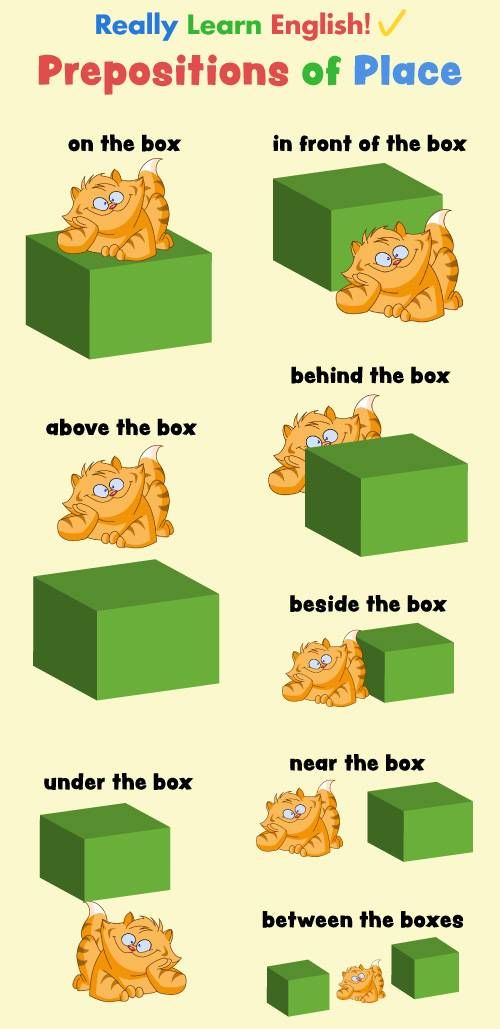 |
| Places | In, before, due to, behind, to, over, under, in front of, at, through, near, past, about etc. | In village, over mountains, over sea, through clearing, near houses, etc. |
| Causes | Because of, from, by, for the sake of, thanks to, due to, in view of, due to | Due to mist, due to fear, for honor, thanks to help, etc. |
| Targets | For, for, by, on, to, for the sake of, for the purpose of, for the purpose of | For colors, for conversation, for security, etc. | |
| Concessions | in spite of | Despite advice, despite persuasion, etc.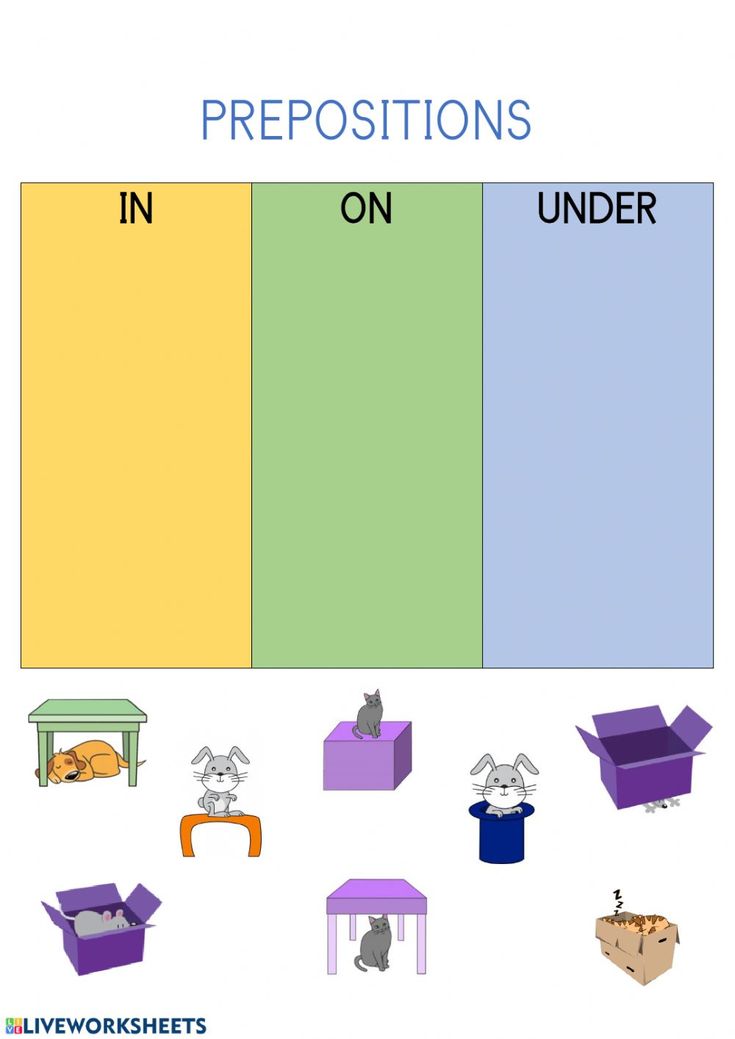 |
| Action object | oh, oh, oh, oh, about | About me, about farmstead, about field, about weather, about work |
| Comparisons | C, like, like, like | Animal like cats, bright like sun, etc. |
| Action | With, without etc. | With sadness, without embarrassment , etc. |
Test yourself
Read the word combinations below and determine which category of meaning the prepositions in them belong to.
Brought from distant countries, called for a conversation, the size of a sparrow, turned away with resentment, go to the well, meet after the ball.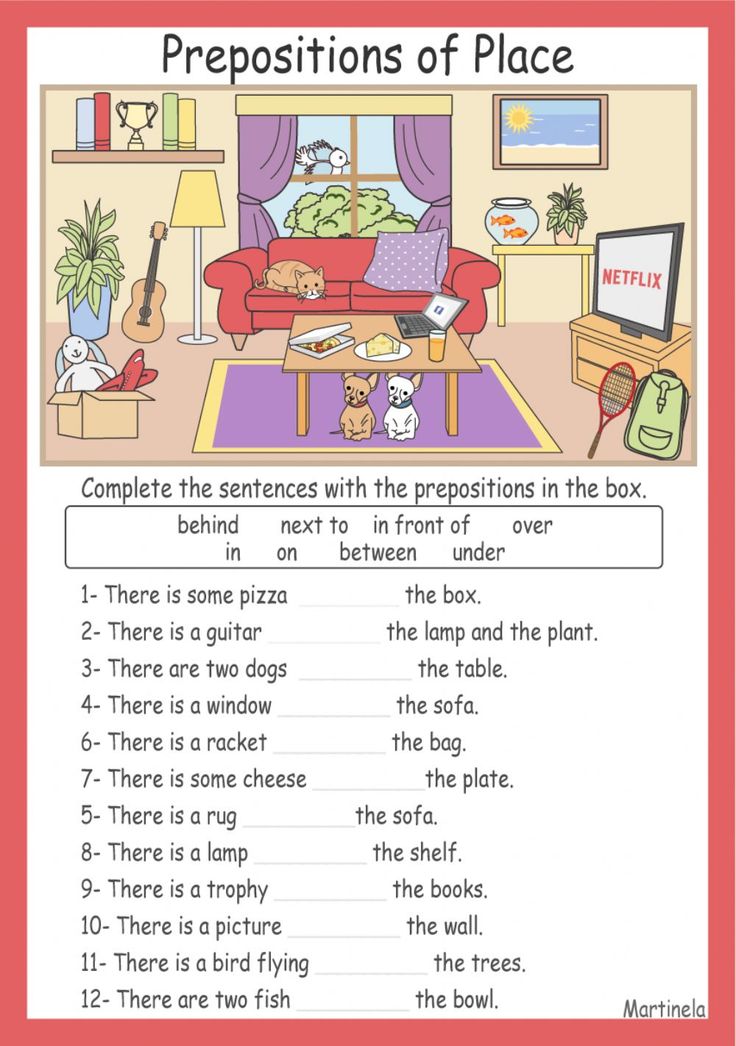
Types of prepositions by composition
By composition, prepositions are divided into simple, complex and compound.
Simple prepositions consist of one word: in, over, under, against , etc. - under , etc.
And the third type - compound - these are prepositions that consist of two or three words, but are written without a hyphen: during, at the expense of etc.
Test yourself
Read the word combinations below and determine what kind of composition the prepositions in them belong to.
He rose above the water, watched for a month, looked out from under the snow, disappeared into the dawn, a plant like a poppy, stopped near the gate.
Types of prepositions by origin
By origin, prepositions are usually divided into derivatives and non-derivatives.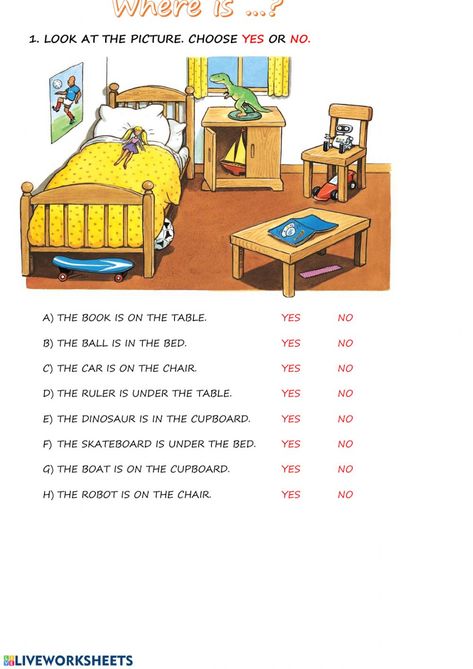
Derived prepositions are those prepositions that come from other parts of speech.
In total, they have three subspecies: nominal, verbal and adverbial. The former were formed from nouns, the latter from gerunds, and the third, as you might guess, from adverbs. Derived prepositions are unambiguous - each of them belongs to only one type in the classification by meaning.
The examples below show that the same words can be both prepositions and other parts of speech in different sentences. It is important to distinguish between them so as not to be mistaken in morphological analysis.
Non-derivative prepositions are prepositions that have not been formed from other parts of speech.
They have always been prepositions and are not like words in other parts of speech. Non-derivative prepositions are often polysemantic, that is, they can refer to two or more types by meaning.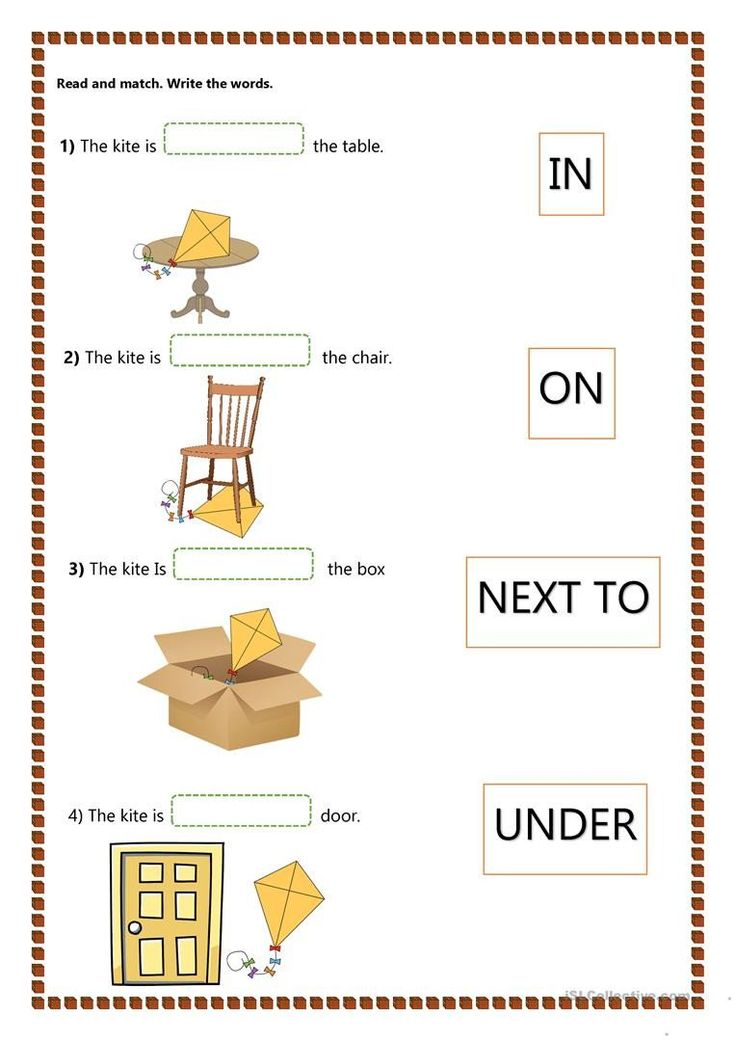
For convenience, we have collected everything you need to know about derivative and non-derivative prepositions in the table below. Save it and use it when you need it!
Check yourself
Read the word combinations below and determine what kind of origin the prepositions in them belong to.
In front of the house, about traveling, near the city, including residents, thanks to the advice, during autumn, around the pond.
Demo lesson in Russian
Take the test at the introductory lesson and find out what topics separate you from the "five" in Russian.
Continuous and separate spelling of prepositions
And now let's talk in more detail about the very tricks of this part of speech, which we talked about at the beginning of the article. The fact is that some of the prepositions can be written together or separately. And if you do not know the peculiarities of their spelling, this can become a problem.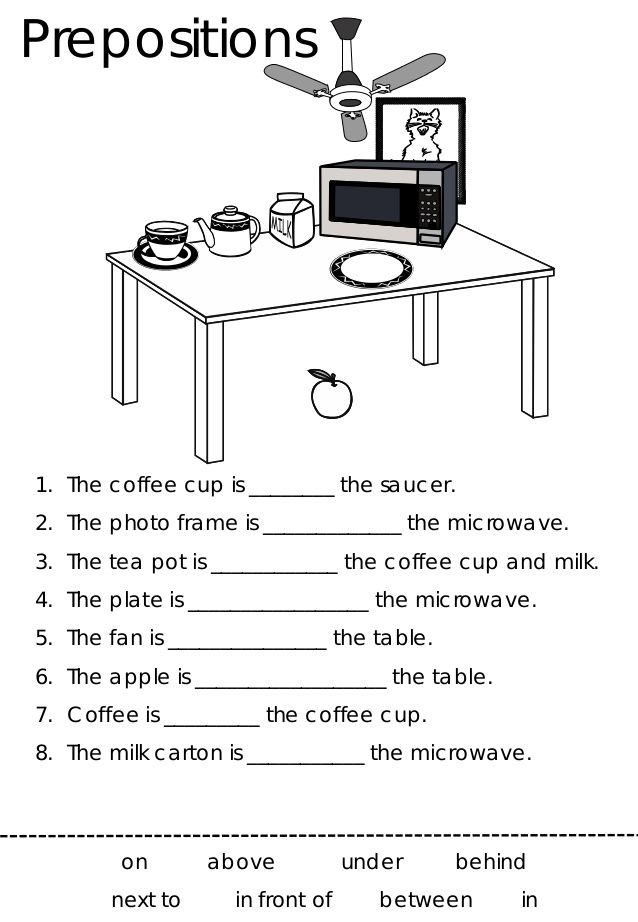 To figure out when prepositions should be written together, and when - separately in Russian, the table with a list of rules and examples below will help.
To figure out when prepositions should be written together, and when - separately in Russian, the table with a list of rules and examples below will help.
| How all prepositions are written in Russian | ||
|---|---|---|
| Kind of prepositions | How to write | Example |
| Plain | In a word | In dreams, over abyss, for protection |
| Complex | Through a hyphen | snow, rain |
| Compounds derivatives | Slitno
|
|
| Separate In some cases, if the preposition is formed from a noun in the oblique case: during, in continuation, in conclusion, in connection with, due to, for the purposes of, due to, in accordance with, in relation to, at the expense of, in the form of, to the extent . Please note: during work, but: arrived on time | As advances, due to flood, due to circumstances | |
Test yourself
Let's see if you understand well what prepositions are and what they serve. Below you will find tasks for self-examination on this topic. Go through them to see if the material is worth repeating.
Task 1
Read the phrases below, find prepositions in them and determine which categories they belong to in all three classifications: by meaning, by composition and by origin.
Above the snow, due to illness, about the weekend, under the table, because of joy, in spite of adversity, to the station, to rest, until tomorrow, to communicate, like a bird, without fatigue.
Task 2
Read the word combinations below and identify which ones use prepositions and which ones use other parts of speech similar to prepositions.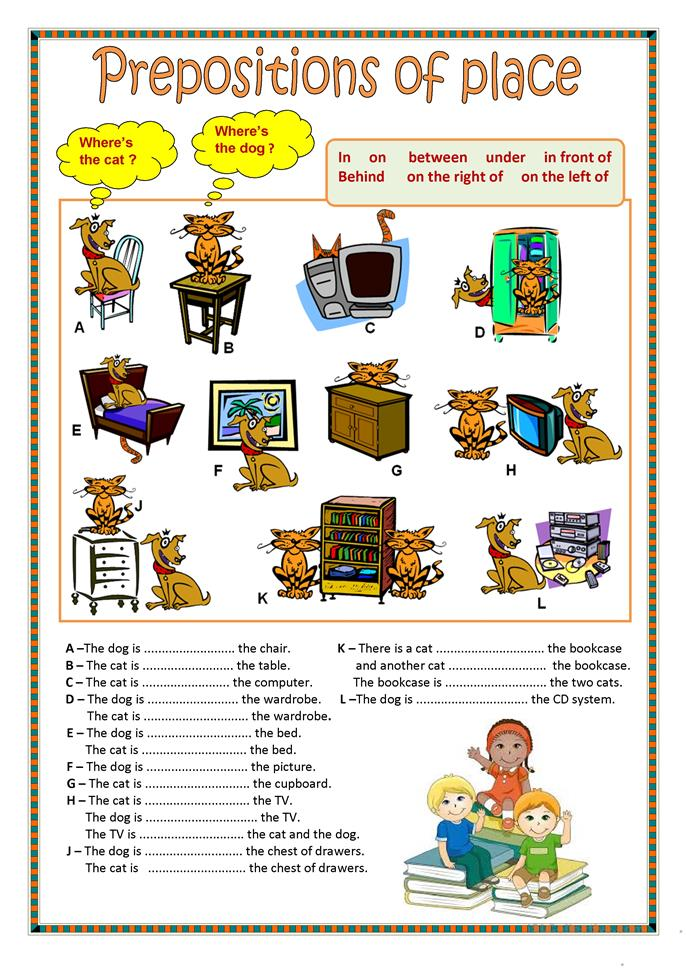 Open parenthesis.
Open parenthesis.
(Not) looking at the noise, (not) looking in her direction, (in) during the evening, (in) the stream, (to) the work account, (to) the bank account, (to) opposite the house, got up (on) against, (on) meeting friends, (on) meeting a dream.
This part of speech is full of pitfalls, but if you understand it, you will never again have to puzzle over how to write: “during” or “in the flow”. If you want to forget about mistakes in prepositions, start studying additionally with a teacher. In the courses at the Skysmart online Russian language school, you will be able to understand the most difficult topics. This will help improve school grades and get more points at the OGE in the future.
is... What are prepositions in Russian?
The preposition is a single word that expresses the dependence of words on each other in combination and in a sentence.
The preposition as a part of speech begins to be studied in the 2nd and 3rd grades.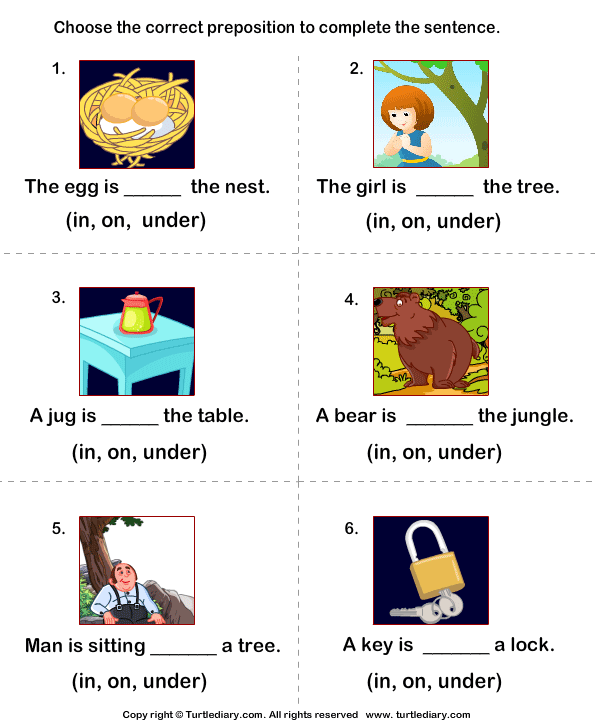 To understand what a preposition is in Russian, let's define what it is used for in speech.
To understand what a preposition is in Russian, let's define what it is used for in speech.
Consider word combinations:
- make a request;
- put in a backpack;
- ride a horse;
- step over the threshold.
Between words denoting an action or an object, there are short words consisting of one, two or more letters. These are suggestions. Prepositions are independent words that are written separately from the words next to them.
Prepositions connect words into a combination or sentence. They express the dependence of some words on others.
Compare:
- house with columns;
- house, columns.
In the first case, from the word "house" , you can ask a question with what? with columns . The preposition "with" shows that the noun "columns" depends on the word "house" .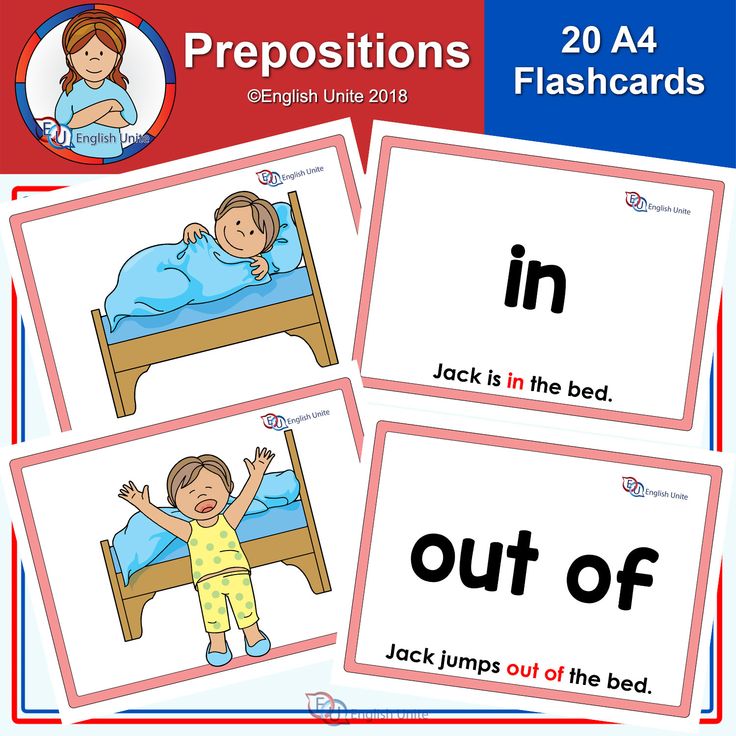
In the second record there are separate words between which there are no relations. Each word exists on its own. They are not related to each other in meaning and grammatically, since there is no preposition between them.
Prepositions are indispensable in speech. Without them, it is impossible to express one's thoughts, to build a coherent statement.
We will verify this by considering the proposal:
The last yellow leaf flew off the tree to the ground.
- (what?) flew off the tree;
- flew (on what?) to the ground .
Prepositions help to form a sentence into a coherent statement filled with a certain meaning. Let's remove the prepositions and get a set of words:
the last yellow leaf flew off the tree to the ground.
Without pretexts, the proposal crumbled like a house of sand. It became difficult to understand what was going on.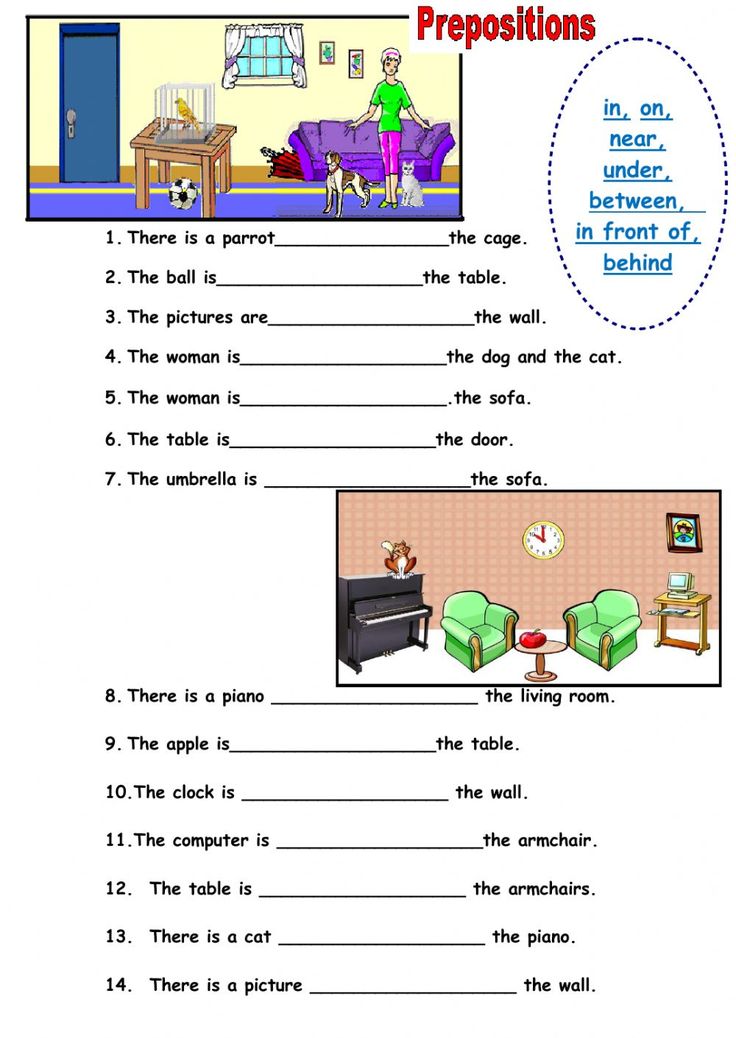
Thus, let's give a definition of what a preposition is:
Definition
The preposition is a word that serves to link words in a phrase and sentence.
Meanings of prepositions
Prepositions do not designate an object like nouns (who? boy what? city ) or action, like verbs (what to do? laugh what to do? write ). However, each preposition has a specific meaning.
Prepositions "in", "on", "under", "above", "behind", "at", "before" indicate where to be.
- grows in the forest;
- sitting on a branch;
- digs underground;
- flies over the house;
- standing behind the house;
- answer at the blackboard;
- stop in front of the door.
Prepositions "to", "from", "to", "from", "to", "through" indicate where to move.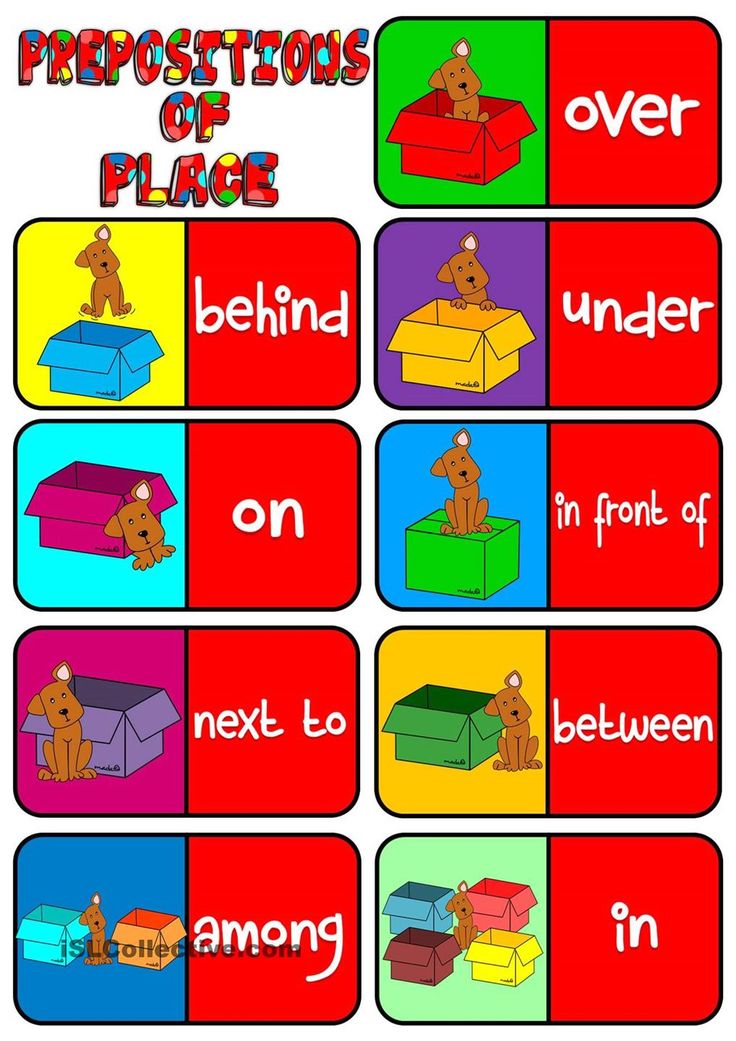
- enter the house;
- leave the classroom;
- carry to the door;
- run to the river;
- cross the bridge.
Prepositions "before", "before", "after", "in" are temporary.
- open till evening;
- two minutes walk from here;
- to arrange after the meeting;
- get ready before the trip.
Difference of prepositions from prefixes
Many prepositions are very similar to the corresponding prepositions:
- touch the wall;
- run into the water;
- throw off the roof.
In these pairs of words, prefixes exist as part of verbs, giving them different meanings.
Let's watch:
run, run, run, run, run, run.
Remember
Verbs do not have prepositions. Only names are used with prepositions.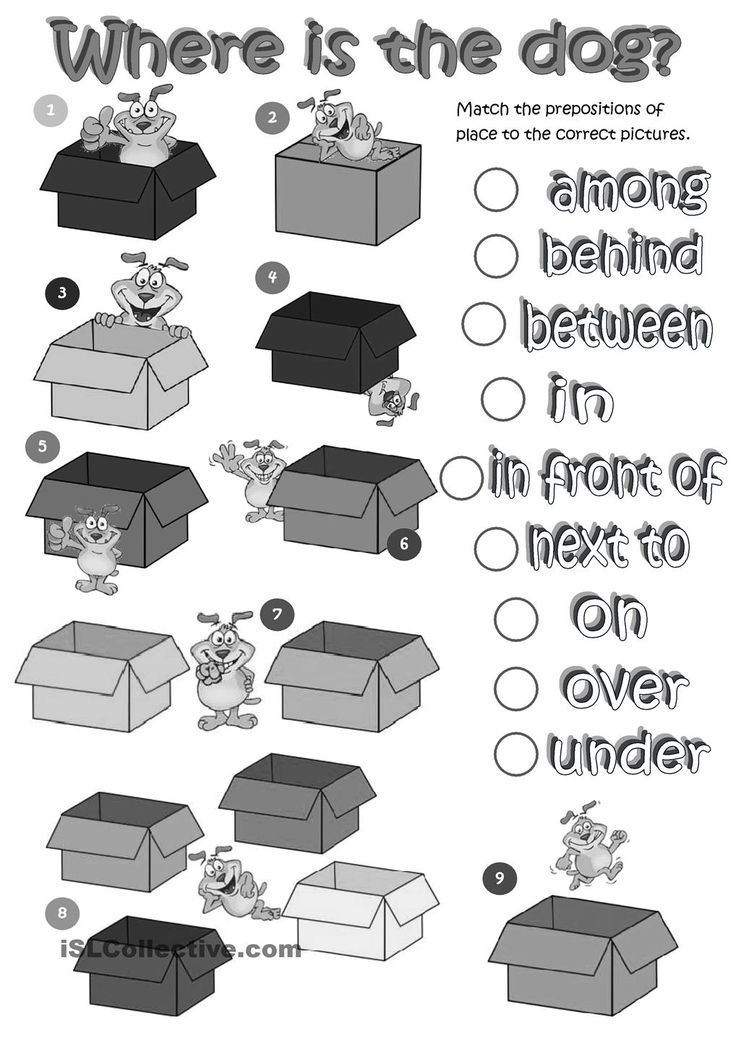
To understand whether it is a prefix or a preposition, let's perform the following verification methods:
Let's see how these tricks work:
- touch (what?) the wall, this wall;
- run (into what?) into the water, into the river water;
- throw (why?) from the roof, from the tiled roof.
An adjective or a pronoun can be inserted as a definition between a preposition and a word.
So, if you can insert a word that names a sign, or a question, this is a preposition. It is written separately from the word.
It is not possible to insert a word between the prefix and the root. The prefix is written together with the word. The prefix in a word can be changed, but the preposition cannot.
Let's read a passage from a fairy tale and indicate the prepositions in it:
Outside the city, near the road, there was a dacha.
